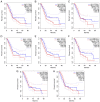Pancreatic stellate cells and the interleukin family: Linking fibrosis and immunity to pancreatic ductal adenocarcinoma (Review)
- PMID: 38994764
- PMCID: PMC11258612
- DOI: 10.3892/mmr.2024.13283
Pancreatic stellate cells and the interleukin family: Linking fibrosis and immunity to pancreatic ductal adenocarcinoma (Review)
Abstract
Pancreatic ductal adenocarcinoma (PDAC) is an extremely aggressive form of cancer with a low survival rate. A successful treatment strategy should not be limited to targeting cancer cells alone, but should adopt a more comprehensive approach, taking into account other influential factors. These include the extracellular matrix (ECM) and immune microenvironment, both of which are integral components of the tumor microenvironment. The present review describes the roles of pancreatic stellate cells, differentiated cancer‑associated fibroblasts and the interleukin family, either independently or in combination, in the progression of precursor lesions in pancreatic intraepithelial neoplasia and PDAC. These elements contribute to ECM deposition and immunosuppression in PDAC. Therapeutic strategies that integrate interleukin and/or stromal blockade for PDAC immunomodulation and fibrogenesis have yielded inconsistent results. A deeper comprehension of the intricate interplay between fibrosis, and immune responses could pave the way for more effective treatment targets, by elucidating the mechanisms and causes of ECM fibrosis during PDAC progression.
Keywords: cancer‑associated fibroblast; interleukin; pancreatic ductal adenocarcinoma; pancreatic intraepithelial neoplasia; pancreatic stellate cell.
Conflict of interest statement
The authors declare that they have no competing interests.
Figures



Similar articles
-
Fibrotic Fortresses and Therapeutic Frontiers: Pancreatic Stellate Cells and the Extracellular Matrix in Pancreatic Cancer.Cancer Med. 2025 Jun;14(11):e70788. doi: 10.1002/cam4.70788. Cancer Med. 2025. PMID: 40437741 Free PMC article. Review.
-
Immune Cell Modulation of the Extracellular Matrix Contributes to the Pathogenesis of Pancreatic Cancer.Biomolecules. 2021 Jun 17;11(6):901. doi: 10.3390/biom11060901. Biomolecules. 2021. PMID: 34204306 Free PMC article. Review.
-
The role of S100A9 in the interaction between pancreatic ductal adenocarcinoma cells and stromal cells.Cancer Immunol Immunother. 2022 Mar;71(3):705-718. doi: 10.1007/s00262-021-03026-y. Epub 2021 Aug 10. Cancer Immunol Immunother. 2022. PMID: 34374812 Free PMC article.
-
Integrin α11 in pancreatic stellate cells regulates tumor stroma interaction in pancreatic cancer.FASEB J. 2019 May;33(5):6609-6621. doi: 10.1096/fj.201802336R. Epub 2019 Feb 26. FASEB J. 2019. PMID: 30808244
-
Persistent activation of pancreatic stellate cells creates a microenvironment favorable for the malignant behavior of pancreatic ductal adenocarcinoma.Int J Cancer. 2013 Mar 1;132(5):993-1003. doi: 10.1002/ijc.27715. Epub 2012 Oct 5. Int J Cancer. 2013. PMID: 22777597 Review.
Cited by
-
Cancer Vaccination and Immune-Based Approaches in Pancreatic Cancer.Cancers (Basel). 2025 Jul 15;17(14):2356. doi: 10.3390/cancers17142356. Cancers (Basel). 2025. PMID: 40723238 Free PMC article. Review.
References
Publication types
MeSH terms
Substances
LinkOut - more resources
Full Text Sources
Medical

